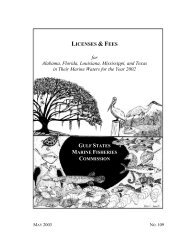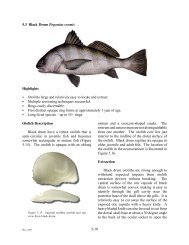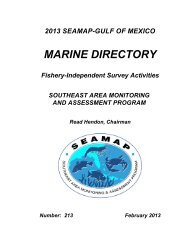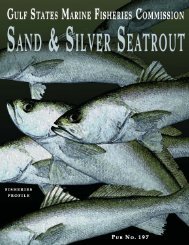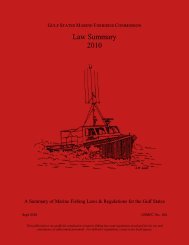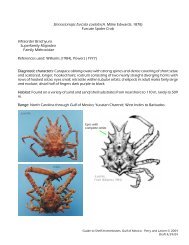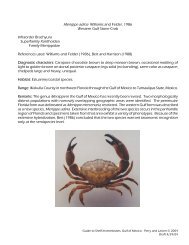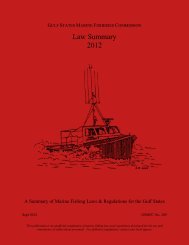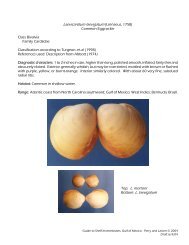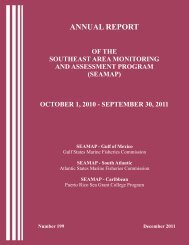Guidelines for Marine Artificial Reef Materials, Second Edition
Guidelines for Marine Artificial Reef Materials, Second Edition
Guidelines for Marine Artificial Reef Materials, Second Edition
Create successful ePaper yourself
Turn your PDF publications into a flip-book with our unique Google optimized e-Paper software.
the U.S. Navy discovered PCBs aboard their surplus vessels in levels high enough to cause<br />
concern.”<br />
The ASMFC ARAC, in its statement, requested from the EPA an assessment of the potential <strong>for</strong><br />
PCBs to cause environmental and human harm in the marine environment as a result of being<br />
present in military vessels used as artificial reefs. The committee also requested that EPA develop<br />
standardized inspection and testing procedures to measure on-board levels of PCBs, and determine<br />
what constitutes acceptable levels of PCBs in the marine environment. The ASMFC ARAC position<br />
was that “states should continue to operate their programs in an environmentally responsible<br />
manner, using surplus ships until the requested EPA standards are adopted.” Regardless of the<br />
ASMFC ARAC stance, the position of the EPA in the 1990s was that deployment of vessels<br />
containing PCBs violated the Clean Water Act (Gregg and Murphey 1994). The EPA position that<br />
disallowed any remnant PCBs on vessels sunk in shallow water, effectively terminated MARAD<br />
federal ship donation activity <strong>for</strong> artificial reefs <strong>for</strong> the next eight years.<br />
In 1995,The EPA’s Office of Pollution Prevention, Pesticides and Toxics prepared a technical policy<br />
document entitled “Sampling Ships <strong>for</strong> PCBs Regulated For Disposal,” (Interim Final Policy,<br />
November 30, 1995) that provided an interim method <strong>for</strong> determining whether PCBs had to be<br />
removed from ships. That document was intended <strong>for</strong> evaluating vessels destined <strong>for</strong> scrapping to<br />
recover metal. The waste and water programs within EPA believed this policy was not appropriate<br />
to use as a guide to PCB removal work on vessels to be sunk in shallow water marine environments<br />
as artificial reefs. To help address the PCB concern, the South Carolina <strong>Marine</strong> <strong>Artificial</strong> <strong>Reef</strong><br />
Program initiated a study to examine the levels of PCBs found in organisms collected from exmilitary<br />
ships which had been sunk as artificial reefs. After confirming the presence of PCB-laden<br />
materials, fishes and invertebrates were collected from the ship reefs as well as from natural hardbottom<br />
control sites. Analyses revealed no significant differences in PCB concentrations between<br />
any of the sites. In addition, the levels that were detected were well below concentrations deemed<br />
hazardous by the FDA (Martore et al. 1997). In the late 1990s, the Navy also commenced laboratory<br />
PCB leach rate studies, and deepwater PCB studies on military ships sunk in 6000 feet or greater,<br />
as well as risk analysis on environmental and human health effects of PCBs . Findings and<br />
recommendations from the Navy studies will be available by the summer of 2003 and are expected<br />
to verify the results of South Carolina’s preliminary testing (Frank Stone, personal communication).<br />
In 2001, the EPA Office of Pollution<br />
Prevention, Pesticides, and Toxics program<br />
operating under the TSCA developed<br />
additional guidelines that helped address<br />
the situation of the Spiegel Grove project<br />
that had been languishing <strong>for</strong> several years<br />
awaiting resolution of the PCB issue.<br />
Without allowances <strong>for</strong> some low level of<br />
PCBs to remain on military ships proposed<br />
to be sunk as artificial reefs, no vessel could<br />
be cost-effectively prepared <strong>for</strong> sinking. In<br />
response to this dilemma, the EPA Office<br />
of Pollution, Prevention, Pesticides and<br />
Toxics program considered use of a<br />
-17-



